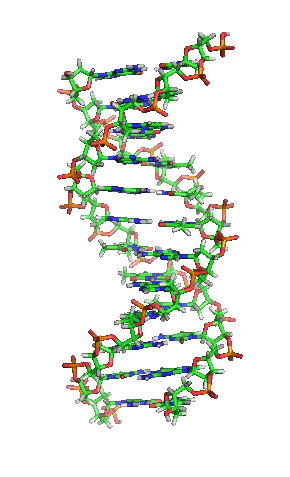
Note: for a much deeper dive into DNA, head over to DNA and DNA replication (HS level)
1. Overview: DNA and RNA are life’s molecules of information
Nucleic acids — DNA and RNA — are the fourth class of macromolecules. The function of these molecules is to store and transmit genetic information.
Why are these substances called nucleic acids? Because they’re acidic, and found mostly in the nucleus of cells.
1a. DNA
DNA stands for deoxyribonucleic acid. It’s the molecule of heredity. That means that
- It’s what genes are made of. The genes that you inherited from your parents were transmitted to you through DNA that came to you through your father’s sperm cell and your mother’s egg cell.
- In the nucleus of your cells (number 4 in the diagram below), DNA (at 3) contains the instructions that tell your cells what to do.
-
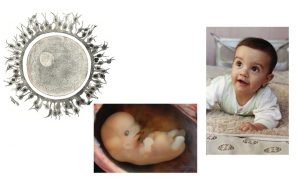
DNA guides development As your body developed from a single fertilized egg cell, your DNA specified the overall developmental pattern. Ignoring influences from the environment, you look the way you look because of your DNA.
As we’ll see below, DNA is composed of chemical “letters.” Combinations of those letters specify proteins. Proteins, in turn, directly or indirectly influence everything else about a cell or an entire organism. So you can think of the instructions in DNA as recipes for making proteins.
1b. RNA
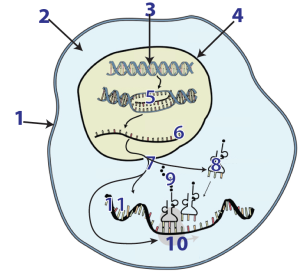 RNA stands for ribonucleic acid. In cells, RNA plays several different roles:
RNA stands for ribonucleic acid. In cells, RNA plays several different roles:
- As messenger RNA (shown at 1 in the diagram at right), it carries information about what proteins the cell should make. This information moves from the cell’s nucleus (at 4) to ribosomes (10) in the cell’s cytoplasm.
- As ribosomal RNA, it makes up ribosomes, the cell’s protein factories.
- As transfer RNA (8), it carries amino acids from the cytoplasm to the ribosomes, where they can be assembled into proteins.
Another important role played by RNA occurs only in certain viruses, where RNA — not DNA — is the genetic material. One such virus is SARS-CoV-2.
2. The Structure of DNA
This course contains complete modules on DNA and RNA. The goal for now is to understand the basic features of DNA and RNA, and to see how DNA and RNA compare to each other, and to the other molecules of life (carbohydrates, lipids, and proteins). We’ll start with DNA.
DNA —like proteins and polysaccharides — is a polymer. The monomers that make up DNA are called nucleotides.
The table below shows the general structure of one of these nucleotides.
| A DNA nucleotide | |
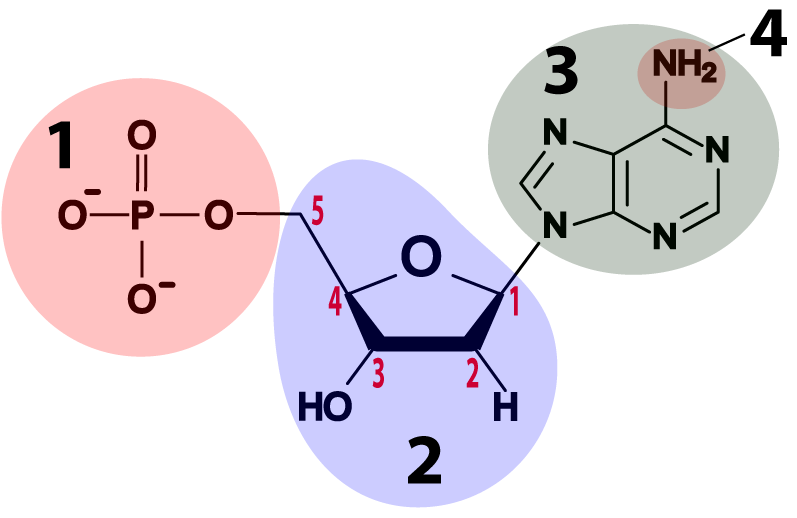 |
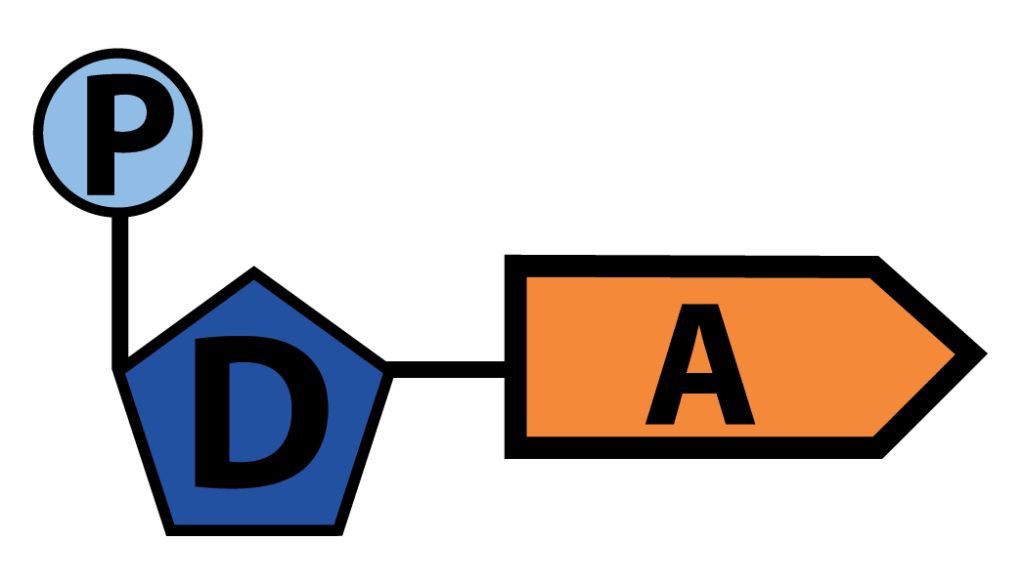 |
| Nucleotide with Adenine (structural formula) |
Nucleotide with adenine (cartoon representation) |
Nucleotides have 3 sub-parts. The numbers below correspond to the numbers in the structural formula diagram to the left.
- A phosphate group.
- A five carbon sugar. Note that if you’re wondering where the carbons are, they’re indicated by the red numbers.
- One of four nitrogenous bases. They’re called “nitrogenous bases” because they’re basic (as opposed to acidic) and they have many nitrogen atoms. The nitrogenous bases are the “letters” that enable DNA to store and transmit information. The four bases are adenine (A), thymine (T), cytosine (C), and guanine (G).
Using the cartoon representation above, here are the four DNA nucleotides:
The Four DNA nucleotides: cartoon representations |
|
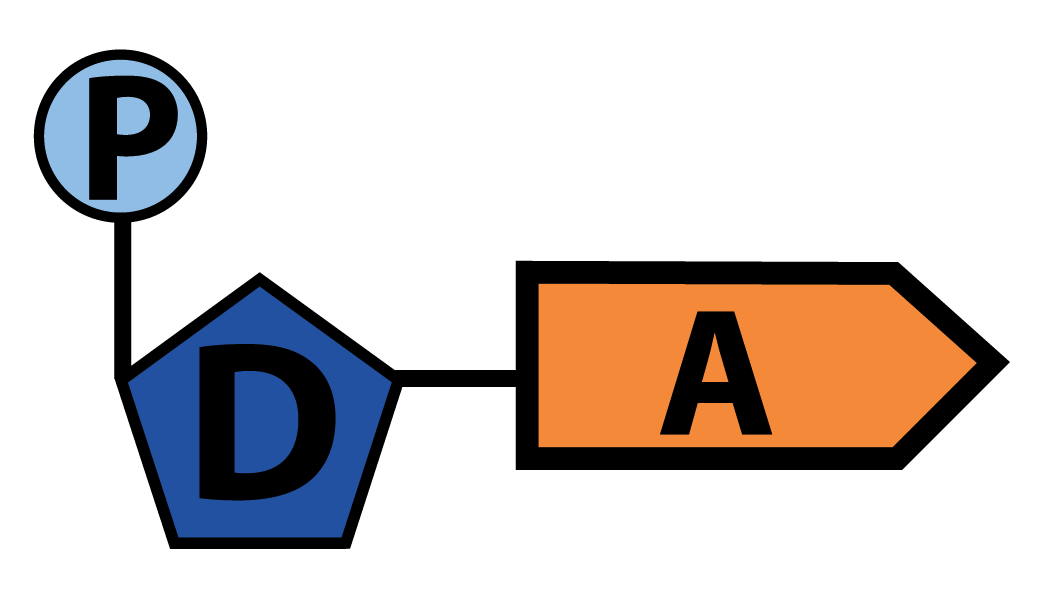 |
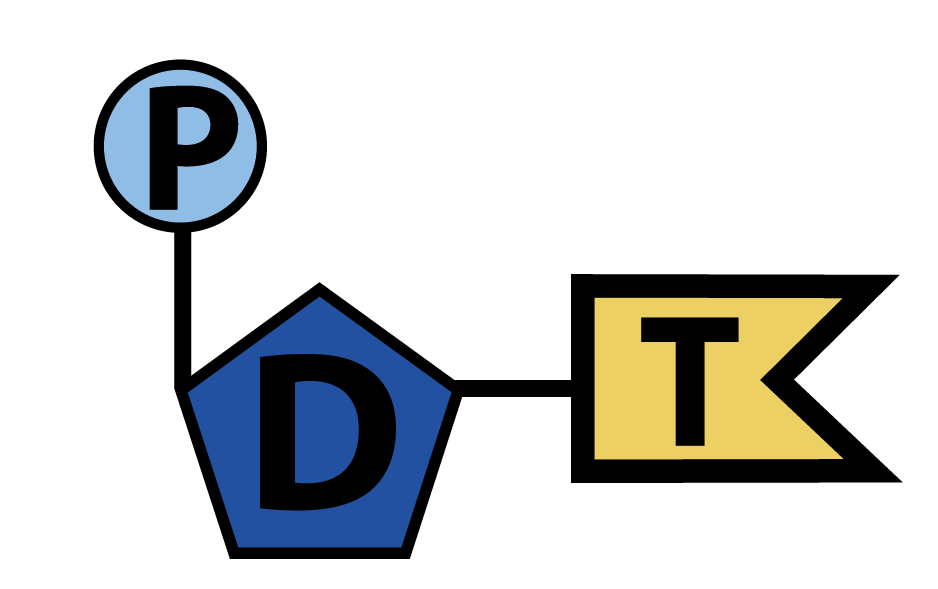 |
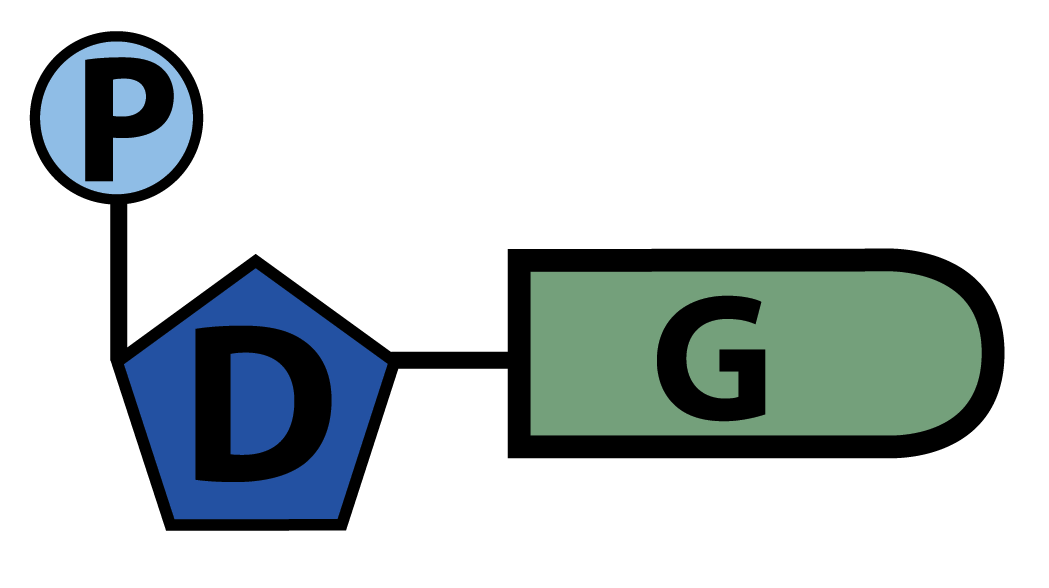 |
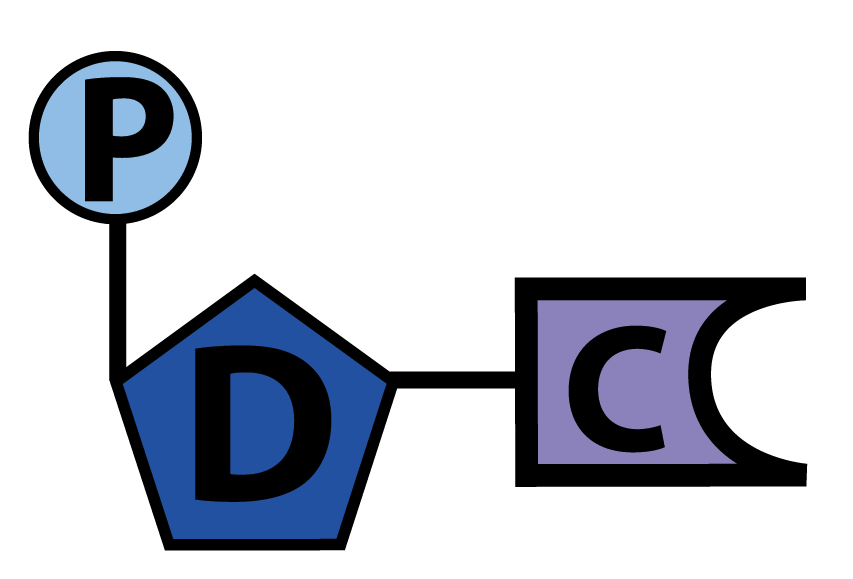 |
In cells, the nucleotides connect to form DNA, shown in a flattened out form below. Here’s a few things to note:
- DNA is double stranded.
- Each single strand is connected by bonds between the phosphate groups and the deoxyribose sugars. This is called the sugar phosphate backbone.
- The strands connect in the middle through bonds that connect certain nitrogenous bases. These connected bases are called base pairs. Base pairing follows these rules.
- A (adenine) connects with T (thymine).
- C (cytosine) connects with G (guanine).

The bonds between the bases are hydrogen bonds, which are much weaker than the covalent bonds that connect sugars to phosphates, and which hold each individual nucleotide together.
| The dotted lines between complementary bases indicate hydrogen bonds | |
| Guanine-Cytosine | Adenine-Thymine |
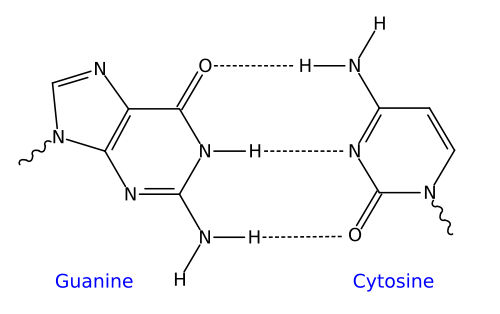 |
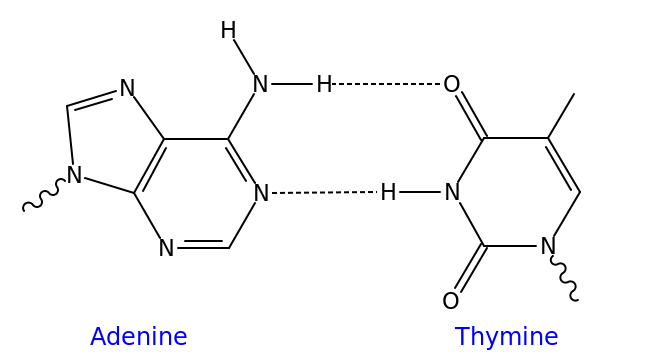 |
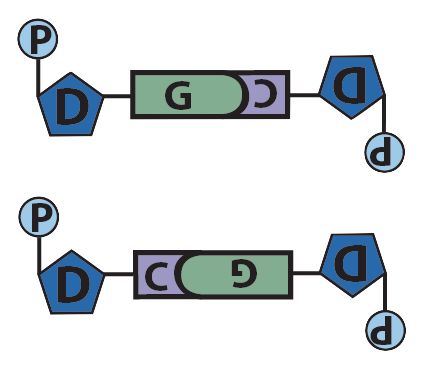 |
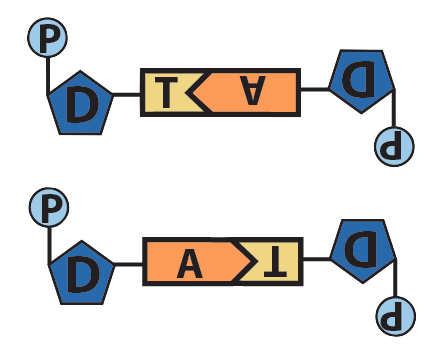 |
Put all of this together, and you get the structure shown below. Because of the bond angles that connect one nucleotide to the next, each DNA stand twists into a corkscrew-like shape called a helix. Because DNA consists of two strands, it’s typically referred to as a double helix.
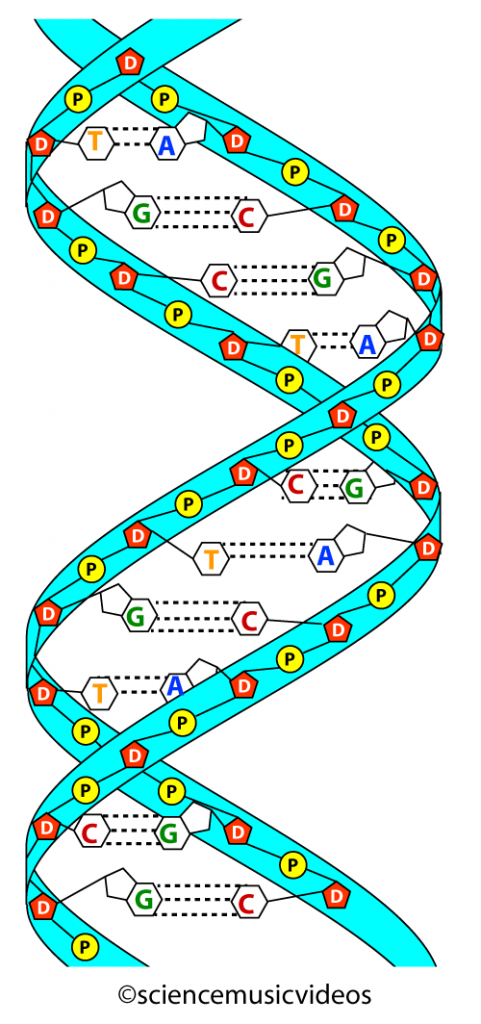
Let’s focus again on the hydrogen bonds that connect the bases. They play a key role in both DNA’s structure and function.
Structurally, they hold the two strands together.
Functionally, they do two things:
- First, the hydrogen bonds make DNA easy to replicate. That’s because the hydrogen bonds, as chemical bonds go, are relatively weak. They can easily be broken by enzymes. That separates the DNA into its two separate strands. When the two strands separate, each single strand can serve as a template for synthesis of a new strand. That’s essential, because passing on DNA is the basis of heredity, so DNA has to be easy to copy in order to carry out this function.
- Second, for the same reason, the hydrogen bonds make it easy for DNA to be made into RNA, which enables the cell to “know” what proteins it needs to make.
3. Nucleic Acids Overview, and DNA: Checking Understanding
[qwiz random = “false” qrecord_id=”sciencemusicvideosMeister1961-Nucleic acids overview (HS)”]
[h] DNA and Nucleic Acids: Checking Understanding
[q] When parents pass genes on to their offspring, they’re doing it through transmission of [hangman].
[c]IEROQQ==[Qq]
[f]IENvcnJlY3Qh[Qq]
[q] To use a metaphor from the kitchen, DNA provides the [hangman]s that cells follow in order to make two other types of molecules. One is another nucleic acid called [hangman] (shown at 5); the second is [hangman] (shown at 8: a polymer of amino acids).
[c]IHJlY2lwZQ==[Qq]
[f]IEV4Y2VsbGVudCE=[Qq]
[c]IFJOQQ==[Qq]
[f]IENvcnJlY3Qh[Qq]
[c]IHByb3RlaW4=[Qq]
[f]IEdyZWF0IQ==[Qq]
[q] In multicellular animals like ourselves, DNA also guides the pattern of [hangman] by which a fertilized egg develops into a multicellular organism.
[c]IGRldmVsb3BtZW50[Qq]
[f]IEV4Y2VsbGVudCE=[Qq]
[q] The only place where RNA acts as the molecule of heredity is within the infectious particles known as [hangman].
[c]IHZpcnVzZXM=[Qq]
[f]IEdvb2Qh[Qq]
[q] The monomers of nucleic acids are called [hangman] (one of which is shown below)
[c]IG51Y2xlb3RpZGVz[Qq]
[f]IEV4Y2VsbGVudCE=[Qq]
[q] The three subparts of a nucleotide are a five carbon [hangman] (at “2”), a nitrogenous [hangman] (at “3”) , and a [hangman] group (at “1”).
[c]IHN1Z2Fy[Qq]
[f]IEdvb2Qh[Qq]
[c]IGJhc2U=[Qq]
[f]IEdyZWF0IQ==[Qq]
[c]IHBob3NwaGF0ZQ==[Qq]
[f]IEV4Y2VsbGVudCE=[Qq]
[q]The table below shows the four [hangman] that make up DNA. Within each one of these molecules, the sugar and [hangman] are identical. It’s the unique [hangman] that makes each different.
[c]bnVjbGVvdGlkZXM=[Qq]
[c]cGhvc3BoYXRl[Qq]
[c]YmFzZQ==[Qq]
[q] DNA is the molecule of [hangman].
[c]IGhlcmVkaXR5[Qq]
[f]IEV4Y2VsbGVudCE=[Qq]
[q] The flow of information in a cell starts with [hangman] (at “3”) in the cell’s nucleus. Then, the information in DNA is transformed into [hangman] (at “6”) which takes that information out to cytoplasm. There, the information gets transformed into [hangman] at (“9”).
[c]IEROQQ==[Qq]
[f]IEdvb2Qh[Qq]
[c]IFJOQQ==[Qq]
[f]IEdyZWF0IQ==[Qq]
[c]IHByb3RlaW4=[Qq]
[f]IEdyZWF0IQ==[Qq]
[q] In the diagram below, what number represents DNA?
[textentry single_char=”true”]
[c]ID M=[Qq]
[f]IEV4Y2VsbGVudCwgJiM4MjIwOzMmIzgyMjE7IGlzIEROQS4=[Qq]
[c]IEVudGVyIHdvcmQ=[Qq]
[c]ICo=[Qq]
[f]IE5vLiBSZW1lbWJlciB0aGF0IEROQSBpcyBhIGRvdWJsZSBoZWxpeC4=[Qq]
[q] In the diagram below, what number represents a molecule of RNA that’s still in the nucleus?
[textentry single_char=”true”]
[c]ID Y=[Qq]
[f]IE5pY2Ugam9iLCAmIzgyMjA7NiYjODIyMTsgcmVwcmVzZW50cyBSTkEgaW4gdGhlIG51Y2xldXM=[Qq]
[c]IEVudGVyIHdvcmQ=[Qq]
[c]ICo=[Qq]
[f]IE5vLiBSZW1lbWJlciB0aGF0IFJOQSBpcyBhIHNpbmdsZSBzdHJhbmRlZCBtb2xlY3VsZS4=[Qq]
[q] DNA can be thought of as a recipe for protein. In the diagram below, protein is represented by number
[textentry single_char=”true”]
[c]ID k=[Qq]
[f]IFdheSB0byBnbyAmIzgyMjA7OSYjODIyMTsgcmVwcmVzZW50cyBwcm90ZWluLg==[Qq]
[c]IEVudGVyIHdvcmQ=[Qq]
[c]ICo=[Qq]
[f]IE5vLiBSZW1lbWJlciB0aGF0IHByb3RlaW5zIGFyZSBwb2x5bWVycyBvZiBhbWlubyBhY2lkcywgc3ludGhlc2l6ZWQgYXQgcmlib3NvbWVzLiBJZiAxMCBpcyBhIHJpYm9zb21lLCB0aGVuIHdoYXQgbnVtYmVyIHdvdWxkIGhhdmUgdG8gcmVwcmVzZW50IHByb3RlaW5zPw==[Qq]
[x]
[restart]
[/qwiz]
4. DNA v. RNA
Start by analyzing the diagram below. See if you can identify all the ways in which DNA and RNA are similar, and how they’re different.
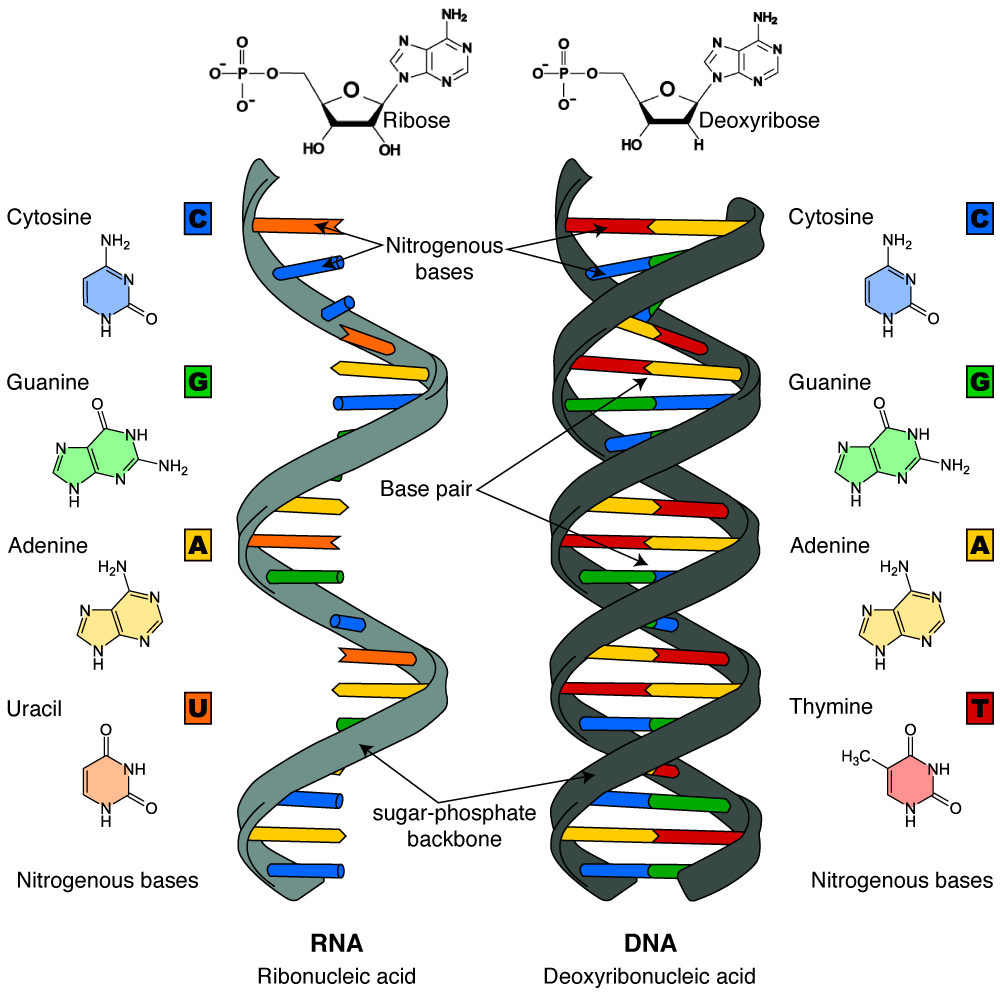
Now, complete the paragraph below. Some of the answers come from the 1st section of this tutorial.
[qwiz qrecord_id=”sciencemusicvideosMeister1961-DNA v RNA (HS)”]
[h]Comparing DNA and RNA
[q]DNA and RNA are similar in that they’re both [hangman] acids. In both substances, the monomers are [hangman]. The monomers of DNA and RNA, however, have one important difference. Whereas the sugar in DNA is [hangman], the sugar in RNA is [hangman].
[c]bnVjbGVpYw==[Qq]
[c]bnVjbGVvdGlkZXM=[Qq]
[c]ZGVveHlyaWJvc2U=[Qq]
[c]cmlib3Nl[Qq]
[q]Another difference is obvious. DNA is a [hangman] helix, consisting of [hangman] intertwined helices. By contrast, RNA consists of only [hangman] strand.
[c]ZG91Ymxl[Qq]
[c]dHdv[Qq]
[c]b25l[Qq]
[q]There are also similarities and differences in terms of the nitrogenous [hangman]. Three of the bases, represented by the letters C, G, and A are the same. The last base is different. In RNA the base [hangman] (represented by “U”) substitutes for [hangman] in DNA (represented by a “T”).
[c]YmFzZXM=[Qq]
[c]dXJhY2ls[Qq]
[c]dGh5bWluZQ==[Qq]
[/qwiz]
5. Nucleic Acids: Cumulative quiz
The purpose of this tutorial was to give you an overview of nucleic acids. Related modules in this course include DNA structure and replication, how DNA controls the cell through transcription and translation.
But for now, let’s consolidate everything we’ve learned about nucleic acids by by taking a quiz. And, just to help you consolidate your memory about the other molecules that make up living things, be prepared for a few questions about carbohydrates, lipids, and proteins, too.
[qwiz random = “false” style=”width: 650px !important;” qrecord_id=”sciencemusicvideosMeister1961-Nucleic Acids (cumulative quiz, HS)”]
[h] Nucleic Acids: Checking Understanding
[i] Biology Haiku
Nucleic Acids
Information molecules
Transmission of genes
[q] The sugar in DNA is [hangman]. The sugar in RNA is [hangman].
[c]IGRlb3h5cmlib3Nl[Qq]
[f]IEdyZWF0IQ==[Qq]
[c]IHJpYm9zZQ==[Qq]
[f]IEV4Y2VsbGVudCE=[Qq]
[q] Whereas DNA has the nitrogenous base thymine, RNA uses [hangman].
[c]IHVyYWNpbA==[Qq]
[f]IENvcnJlY3Qh[Qq]
[q]With the exception of lipids, the molecules that make up living things mostly are polymers, made up of smaller units called monomers. The monomers of carbohydrates are monosaccharides, also known as simple [hangman]. The monomers of proteins are the [hangman] acids. The monomers of [hangman] acids are nucleotides. An important building block of lipids are the [hangman] acids.
[c]c3VnYXJz[Qq]
[c]YW1pbm8=[Qq]
[c]bnVjbGVpYw==[Qq]
[c]ZmF0dHk=[Qq]
[q] Like proteins and polysaccharides, both DNA and RNA are built from multiple repeating subunit, making them [hangman]. The bonds that connect the nucleotide monomers are called [hangman]-[hangman] bonds (one of which is indicated by the arrow below).
[c]IHBvbHltZXJz[Qq]
[f]IEdvb2Qh[Qq]
[c]IHN1Z2Fy[Qq]
[f]IENvcnJlY3Qh[Qq]
[c]IHBob3NwaGF0ZQ==[Qq]
[f]IEdyZWF0IQ==[Qq]
[q] In the diagram below, the structure shown at “1” is the sugar-phosphate [hangman]. Connected to each sugar are nitrogenous [hangman] (shown at “2”).
[c]IGJhY2tib25l[Qq]
[f]IEdvb2Qh[Qq]
[c]IGJhc2Vz[Qq]
[f]IEV4Y2VsbGVudCE=[Qq]
[q] In the diagram below, the number that refers to the informational part of the molecule is
[textentry single_char=”true”]
[c]ID I=[Qq]
[f]IEV4Y2VsbGVudC4gSW4gbnVjbGVpYyBhY2lkcywgaW5mb3JtYXRpb24gaXMgc3RvcmVkIGluIHRoZSBzZXF1ZW5jZSBvZiB0aGUgbml0cm9nZW5vdXMgYmFzZXMsIHdoaWNoIGFyZSBzaG93biBhdCAmIzgyMjA7Mi4mIzgyMjE7[Qq]
[c]IEVudGVyIHdvcmQ=[Qq]
[f]IE5vLCB0aGF0JiM4MjE3O3Mgbm90IGNvcnJlY3Qu[Qq]
[c]ICo=[Qq]
[f]IE5vLiBJbmZvcm1hdGlvbiBpcyBzdG9yZWQgaW4gdGhlIHNlcXVlbmNlIG9mIG5pdHJvZ2Vub3VzIGJhc2VzLiBXaGljaCBudW1iZXIgcmVmZXJzIHRvIHRoYXQgcGFydD8=[Qq]
[q] The bonds between adenine and thymine below are[hangman] bonds.
[c]IGh5ZHJvZ2Vu[Qq]
[f]IENvcnJlY3Qh[Qq]
[q] The accuracy of DNA replication is based on the fact that adenine can only bond with [hangman], and cytosine can only bond with [hangman].
[c]IHRoeW1pbmU=[Qq]
[f]IENvcnJlY3Qh[Qq]
[c]IGd1YW5pbmU=[Qq]
[f]IEV4Y2VsbGVudCE=[Qq]
[q] In DNA, information is stored in the [hangman] of the nitrogenous bases.
[c]IHNlcXVlbmNl[Qq]
[f]IEdyZWF0IQ==[Qq]
[q] In the diagram below, genetic information in the form of [hangman] (at “3”) gets made into [hangman] (at “5”), which then goes to the cytoplasm where it’s translated by a ribosome into [hangman] (at “8”).
[c]IEROQQ==[Qq]
[f]IEdvb2Qh[Qq]
[c]IFJOQQ==[Qq]
[f]IEV4Y2VsbGVudCE=[Qq]
[c]IHByb3RlaW4=[Qq]
[f]IEdyZWF0IQ==[Qq]
[q] Whereas DNA is almost always [hangman] stranded, RNA is [hangman] stranded.
[c]IGRvdWJsZQ==[Qq]
[f]IEV4Y2VsbGVudCE=[Qq]
[c]IHNpbmdsZQ==[Qq]
[f]IEV4Y2VsbGVudCE=[Qq]
[q] In the diagram below, hydrogen bonds are indicated by which number?
[textentry single_char=”true”]
[c]ID Y=[Qq]
[f]IEV4Y2VsbGVudC4gSHlkcm9nZW4gYm9uZHMgYXJlIHNob3duIGF0ICYjODIyMDsyLiYjODIyMTs=[Qq]
[c]IEVudGVyIHdvcmQ=[Qq]
[f]IE5vLCB0aGF0JiM4MjE3O3Mgbm90IGNvcnJlY3Qu[Qq]
[c]ICo=[Qq]
[f]IE5vLiBIZXJlJiM4MjE3O3MgYSBoaW50LiBUaGUgaHlkcm9nZW4gYm9uZHMgaG9sZCB0aGUgdHdvIHN0cmFuZHMgdG9nZXRoZXIu[Qq]
[q] In the diagram below, deoxyribose sugars are represented by which number?
[textentry single_char=”true”]
[c]ID E=[Qq]
[f]IFdheSB0byBnbyEgRGVveHlyaWJvc2Ugc3VnYXJzIGFyZSBzaG93biBhdCAmIzgyMjA7MS4mIzgyMjE7[Qq]
[c]IEVudGVyIHdvcmQ=[Qq]
[f]IE5vLCB0aGF0JiM4MjE3O3Mgbm90IGNvcnJlY3Qu[Qq]
[c]ICo=[Qq]
[f]IE5vLiBIZXJlJiM4MjE3O3MgYSBoaW50LiBUaGUgc3VnYXJzIGhhdmUgNSBjYXJib25zLCBhbmQgYXJlIG9mdGVuIHJlcHJlc2VudGVkIGJ5IGEgcGVudGFnb24u[Qq]
[q] In the diagram below, which number represents the part that contains the genetic information?
[textentry single_char=”true”]
[c]ID Q=[Qq]
[f]IEdvb2Qgd29yay4gVGhlIG5pdHJvZ2Vub3VzIGJhc2VzLCBzaG93biBhdCAmIzgyMjA7NCwmIzgyMjE7IGNvbnRhaW4gZ2VuZXRpYyBpbmZvcm1hdGlvbi4=[Qq]
[c]IEVudGVyIHdvcmQ=[Qq]
[f]IE5vLCB0aGF0JiM4MjE3O3Mgbm90IGNvcnJlY3Qu[Qq]
[c]ICo=[Qq]
[f]IE5vLiBIZXJlJiM4MjE3O3MgYSBoaW50LiBHZW5ldGljIGluZm9ybWF0aW9uIGlzIHN0b3JlZCBpbiB0aGUgc2VxdWVuY2Ugb2Ygbml0cm9nZW5vdXMgYmFzZXMu[Qq]
[x]
[restart]
[/qwiz]
What’s next?
Go to The Molecules of Life Main Menu, or use the menus above to choose another module.
